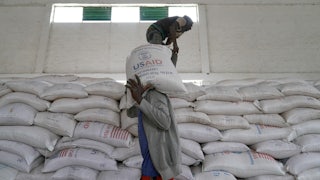Three hours before a would-be assassin was spotted hiding in the bushes of his golf course in West Palm Beach, Donald Trump posted, in all caps, “I HATE TAYLOR SWIFT” on Truth Social, his wildly unprofitable social network. At roughly the same time, his running mate, Ohio Senator J.D. Vance, was touring the Sunday shows to proudly admit that he and Trump were knowingly spreading racist lies about Haitian immigrants eating pets, in service of an even bigger lie—that immigrants pose an existential threat to the country itself.
It was a banner day for the Trump campaign: a feud with the country’s most popular pop star, a vile lie about a vulnerable population, yet another close call with an attempted assassin. But it also felt oddly familiar, bordering on routine—especially given how the former president and his allies reacted to the golf course scare. There were no fleeting calls for “unity” or hollow promises to turn down the temperature; instead, they were quick to blame their political opponents.
In a speech on Monday, Vance noted that the two attempts on Trump’s life were “pretty strong evidence that the left needs to tone down the rhetoric or somebody is going to get hurt.” He further argued on X that the captured suspect, Ryan Routh, was inspired by the Harris campaign’s insistence that Trump is a threat to democracy. Trump, meanwhile, said his opponents’ inflammatory rhetoric was endangering him, and that “these are people who want to destroy this country.”
“It is called the enemy from within,” Trump continued. “They are the real threat.” If that wasn’t subtle enough, his campaign then released a lengthy list of people it blamed, without evidence, for inspiring Routh, including Harris and her running mate, Governor Tim Walz, as well as Representative Nancy Pelosi, Representative Adam Schiff, and even Walz’s wife, Gwen.
It would be foolish to blame any politician for either assassination attempt; both Routh and Thomas Crooks, the deceased Pennsylvania shooter, were mentally troubled and politically confused. But it’s important to acknowledge a simple and obvious truth: No one in this country has done more to sow division, create chaos, and, yes, encourage violence over the past decade than Trump. It was only a matter of time before that boomeranged on him.
Criticisms of Trump that rightfully note that he is a threat to the future of American democracy are hardly incitement to violence. They are recognition of the fact that Trump has used and will continue to use any means at his disposal to gain and hold onto power. His own paranoia and deluded ravings about his political enemies, meanwhile, have created a combustible climate—one made more dangerous by the lax gun laws that Trump and his allies have embraced.
These are people who egg on violence against their enemies at every turn. As The New York Times’ Peter Baker put it on Monday, Trump has “long favored the language of violence in his political discourse, encouraging supporters to beat up hecklers, threatening to shoot looters and undocumented migrants, mocking a near-fatal attack on the husband of the Democratic House speaker and suggesting that a general he deemed disloyal be executed.” Let’s not forget that he also directed his supporters to attack the U.S. Capitol and allegedly expressed support for hanging his vice president, Mike Pence.
And then, Trump cries victim when he finds himself in the crosshairs. But increasingly, it seems, Americans aren’t buying it. For the last two months, the Trump campaign has whined incessantly about the fact that the country quickly moved on following the first attempt on his life, in mid-July. They’re right about that; his near-death experience was out of the news within a few days, and Trump received no noticeable bump in the polls. The incident is now an afterthought in the election—it’s almost as if it never happened at all. The second assassination plot, meanwhile, barely registered on NFL Sunday.
The country has moved on because it has grown accustomed to the chaos that Trump effortlessly generates. It has moved on because Trump himself moved on almost immediately. The Trump that stood onstage at the Republican National Convention, rambling about his grievances for almost two hours, was not changed by his recent brush with death in the slightest. He was, if anything, even more deranged and vengeful. And since then, he has said that Kamala Harris is a “fascist,” Walz wants to force young children to have gender reassignment surgeries, and that Haitian immigrants who are in the country legally are pet-eating criminals intent on murdering downtrodden Rust Belt whites.
Years before Trump’s political career began, the British photographer Platon found himself shooting Trump in the boardroom where he fired people on The Apprentice, the show where he played an idealized version of himself—wealthy, important, competent. Platon tried to connect with his subject. “Let’s be human together,” he said to Trump. “There’s always an air of tension and controversy about the things you say and do in public. I’m sure it’s intentional on your part but it feels to me like you’re in the middle of an emotional storm. I can’t live with that anxiety all the time. As a fellow human being, I’d like to know how you weather the storm.”
Trump calmly looked back at him and responded: “I am the storm.”
Trump is one of the least self-aware people in American political history—maybe in history, period. But this was an eerily prophetic statement. For eight years, Trump has been the storm. He unleashed dark forces in our society—making America more violent, more menacing, more chaotic—and rode them to the height of power. Now, he’s trying to do it all over again. But that’s the thing about storms, no matter their origin. Sometimes there’s no escaping them.







